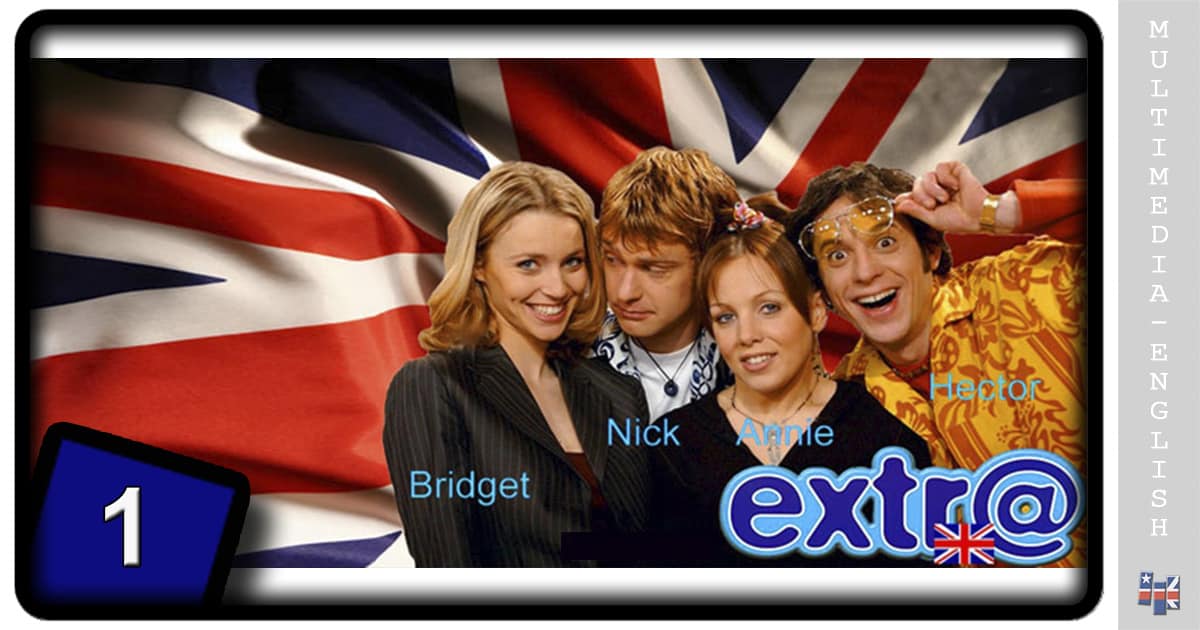It is usually said that the best way to learn English is to learn it while having fun. Therefore, a TV series will absolutely be a joyful option for any English learners, no matter which levels they are in. In today’s article, let’s discover how to learn English with Extr@ (Extra English).
Extr@ is a thirty-episode sitcom specifically designed for language learners. The TV series itself has become a classic among English learners since it has been used in many countries around the world for the purpose of improving English communication. What makes Extr@ different is that the scripts have been carefully written so that the language is simple and accessible at all levels. They combine wit, strong character identification and a good dose of physical humor, making instant connections with the target age group of 14-19. Indeed, Extr@ sounds like the ideal TV series for intermediate-to-advanced English students.
Wait no more, let’s try to learn and practice basic English communication through Extr@ with 4 iconic communication situations with eJOY!
Introduction to Extr@ – What is it about?
The series revolves around the lives of four friends: Anne, Bridget, Nick, and Hector. Anne and Bridget live together in an apartment, Nick is a neighbor and things start to get interesting when Hector – a pen-pal of Bridget moves in to live with them.
In the first episode, Bridget, a fitness enthusiast, receives a letter from her old penfriend in Argentina, Hector, saying that he plans to visit her. When Hector arrives, at first he doesn’t look very attractive and the girls decide that Hector can’t stay with them. That is, until he emerges from the shower! Nick discovers that Hector comes from ‘one of the richest families in Argentina’, but Hector is determined to keep it a secret. Now, both Nick and the girls are very keen for him to stay!

Funny, lovely, Extr@ is a movie for everyone, especially young people because of the entertaining and relatable situations included. This is a great TV series for you to improve your communication skills thanks to the slow speaking speed of the characters, the simple language and the everyday situations. Moreover, 25 minutes per episode is the suitable length for English learners as it is not long enough to bore them and they can always find time to watch it.
Read more
How to learn English effectively through Extr@
Extr@ is undoubtedly an easy-to-watch TV series because of the suitable length as well as the specific content in each episode. However, to optimize the efficiency of learning English through Extr@, I have tried and succeeded by applying the following steps.
1. First of all, watch an entire episode.
You should feel free to use English subtitles or subtitles in your mother tongue depending on your own listening level. This is the time for you to get the general idea of the whole episode and the series as well. If you’re watching the episode in English or dual subtitles, you may want to look up and save new words for later review.
2. Next, choose interesting clips/scenes from the movie to watch again (and again!) and learn.
This is when your learning journey actually begins. Good scenes here can be the ones with a lot of useful words or common dialogues that you want to practice more to improve your speaking skills. Now, seek back to one selected scene and watch it a few more times to make sure that you understand everything that’s said in this scene. If the characters speak too fast, slow it down by choosing Slow mode or adjusting the movie speed level (if there’s one).
Next, practice shadowing (repeating what you hear) and auto-pause listening until you’re able to speak out all of the movie lines in this scene with ease.
3. Watch the episode multiple times and review vocabulary.
Practice makes perfect! The brand new, maybe even strange words, sentences you listen to today may become your natural speaking reflexes in the near future if you spend time practicing. So keep up the good work! Try watching the episode again with dual subtitles and push yourself a little bit more by turning off the native language subtitles completely next time you watch it.
You can also read articles ‘Learn English via movies – An A-Z Guide’ to better understand the steps and suggestions above.
One of the useful tips of mine is that I use eJOY eXtension to translate new words right when I’m watching the series. With the help of eJOY eXtension, to check the meaning, I simply click on the word to see the meaning and pronunciation as well. And when I want to save a word, I simply click “Save”. Moreover, you can practice your saved words daily with eJOY’s interesting games.

4 great scenes to learn English with Extr@
1. Introduce yourself in English (Episode 01 – Hector’s Arrival)
-
Structures to remember
Episode 01 marks the event of Hector’s arrival from Argentina to London and shared an apartment with Anne and Bridget. This is definitely an ideal episode for you to understand how to introduce yourself properly in English. You can achieve this by paying attention to the scence of Hector’s introduction to Anne and Bridget.
Greeting
As soon as Hector met Anne and Bridget, the first sentence Hector and two girls said was “Hello”. Greeting is an indispensable job when starting any conversation. Some common greetings can be mentioned as:
Hi / Hello
Good morning / Good afternoon.
Note: “Good morning/Good afternoon” is formal and should be used in formal and polite communications.
Introduce your name
When people met each other for the first time, after greeting they will have to introduce their names so as to make friends and properly address others. In this episode, Hector used and reiterated the structure “I am called Hector” (I’m Hector) to introduce his name to Anne and Bridget.
In fact, there are many different ways for you to do this, as follows:
My name is + name
I am + name
You can call me + name
I am called + name
Introduce your hometown/homeland
During the introduction, Hector made an odd mistake when talking about his homeland of Argentina. Hector accidentally reversed his name and Argentina, making the sentence “I am from Hector” instead of “I am from Argentina”. However, the structure Hector used is still a standard structure when introducing someone’s hometown.
I am from + hometown
I come from + hometown
Introduce where you live
When Anne and Bridget tried to get to know more about Hector, he said, “I live in a museum.”
This is the basic structure when you want to introduce where you live to other people.
I live in + where you live
- For example
My name is Annie. I am from the USA. I live in a small house in Massachusetts.
2. Go shopping (Episode 02 – Hector goes shopping)
-
Structures to remember
In this episode, Anne, Bridget and Nick both wanted to do a makeover for Hector, starting with buying new clothes for him. Nick and Bridget then pretend to be salespeople to guide Hector on how to make purchases in the US. Therefore, throughout this episode, you will learn many useful structures on how to communicate when going shopping.
Some questions a salesperson may ask when you go shopping:
Can I help you?
Which size? / Which size do you want to wear?
Do you like + items?
When you want to buy a specific item, you can use one of the following structures:
I would like + the item you want to buy + please
Some vocabulary about Clothing mentioned in this episode includes:
- a shirt: a piece of clothing worn on the upper part of the body, made of light cloth like cotton and usually having a collar and buttons at the front
- a pair of trousers: a piece of clothing that covers the lower part of the body from the waist to the feet, consisting of two cylinder-shaped parts, one for each leg, that are joined at the top
- a hat: a covering for the head that is not part of a piece of clothing
- size: one of the standard measures according to which clothings are made or sold
For example
A: Can I help you?
B: I would like a pair of trousers, please.
A: What kind of trousers do you like?
B: A Gray Khaki pair of trousers would be the best.
A: Yes, you can have a look at this. I think it will suit you.
B: This looks good. Can you give me one so I can try it on?
A: Sure. Which size?
B: 38, please.
3. In restaurants (Episode 11 – Holiday time)
In this scene, Anne, Bridget, Nick and Hector went to a British-style tea-house in Barcelona. Let’s see how they communicate and learn from that in case you have to order in English when going to a restaurant!
-
Structures to remember
When booking in advance at a restaurant, you can think of this structure:
Can we reserve a table, please?
When you want to ask what kind of food/drink the restaurant has:
What have you got?
When you want to order:
I would like + food / drink + please
- For example
A: What have you got today?
B: Today we`ve got a new dish called Seafood Risotto and a new desert as well, a Lava cake.
A: That’s great. I would like a Seafood Risotto, please.
4. Talk about places in English – (Episode 06 – Bridget wins the Lottery)
In this episode, Bridget was very happy to know that she won the lottery. However, Hector took Bridget’s ticket by mistake and lost it, making Bridget’s dream of becoming a billionaire vanish into thin air.
During Hector’s search for Bridget’s lottery ticket, you will also learn about how to ask and respond related to the location of a person/object.
- Structures to remember
To ask about the place someone has just arrived from, you should say:
Where have you been?
To answer to this question, you may say:
I came to the CD shop
To ask where certain items are, you can use the structure below:
Where + to be + item?
To ask where someone is:
Where is + somebody?
The answer to this type of question varies depending on the specific case. However, the answer form often has the following general structure:
Subject + to be + preposition + place / location
- For example
A: Where are you, Bridget?
B: I am at the shopping mall
A: Where is the book I have just bought?
B: It is still in your tote bag
Conclusion
Extr@ English promises language learning with laughter, in an authentic America setting. With 30 hilarious, half-hour sitcom programmes, this series is a delight for anyone learning English, especially young adults.
Spend 25 minutes a day to entertain and learn English communication through Extr@ is probably a great choice for joyful learning without too much sweat. To watch this series effectively and minimize the nuisance you often encounter when learning English through movies, take some time to download eJOY eXtension. This will help you look up new words immediately (just click on a new word in the subtitles section) that you can use to search when watching movies on Youtube, Netflix and Iflix.
So let’s grab some popcorn and enjoy learning English with eJOY!














